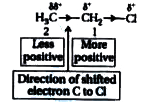Write about Inductive effect
Text Solution
(A) Definition: The electron of bond shift in any molecule and results in a polarity in bond is called inductive effect. ..When a covalent bond is formed between atoms of different electronegativity, the electron density is more towards the more electronegative atom of the bond. It is called inductive effect...
Due to inductive effect, such a shift of electron density results in a polar covalent bond. Bond polarity leads to various electronic effects in organic compounds
Representation of partial charge and electron displacement. The polar covalent bond are denoted by symbol δ (delta) and the shift of electron density is shown by an arrow that points from δ+ to δ− end of the polar bond. δ+ means more partial positive charge and δδ+ means smaller positive charge.
(B) Explanation of example: Cholorethane in which the C-Cl bond is a polar covalent bond, In which the electronegativity of Cl is more than C, So the electron of C-Cl. Therefore partail positive charge (+δ) on C and partial negative charge (−δ) and Cl containing C+δ−Cl−δ polar bond obtain.

Inductive effect and polarity of atoms in CH3CH2Cl.
(C ) Extend strength of inductive effect: (i) As the functional group displacing near then its effect is strong. This effect is induce upto three carbon in chain. In chloro ethane the inductive effect of C1andC2 but it is more effective on C1, So +δ charge on C1 is more and partial charge δδ+ on C2 is less.
(ii) As the no. of groups are more its effect is more. e.g., CH3CHCl2 is more effective than CH3CH2Cl. (iii) As the effect of group is strong the displacement of electron density is more e.g. F, Cl, Br, I inductive effect decreases.
(D) Types of inductive effect: The inductive effect is related to the ability of substituent(s) to either withdraw or donate electron density to the attched carbon atom. Based on this ability, the substituents can be classified as electron-withdrawing (-I) group and electron donating (+I) group.
(i) Electron withdrawing inductive effect (-I) and groups: Atom or groups of atoms having electron-attracting capacity more than hydrogen having -I (electron withdrawing or attacting) effect. For example (X) nitro (−NO2), cyano (−CN), carboxy (−COOH), ester (−COOR), aryloxy (-OAr), alcoxy (-OR), aryl (−C6H5) etc. are electron withdrawing group.
(ii) Electron donation (+I) effects and groups: Atoms or groups of atoms having smaller electron attracting power than hydrogen are reffered to as having +I (electron denoting or repelling) effect
e.g. Methyl (−CH3), ethyl (−CH2CH3),−CH(CH3)2,−C(CH3)3 etc (+I) containing group. If alkyle group are more so, (+I) effect is strong.
|
Topper's Solved these Questions
- ORGANIC CHEMISTRY SOME BASIC PRINCIPLES AND TECHNIQUESBook:KUMAR PRAKASHANChapter:ORGANIC CHEMISTRY SOME BASIC PRINCIPLES AND TECHNIQUESExercise:Section -A(Methods of Purification of Organic Compounds)
Explore 44 Videos
- ORGANIC CHEMISTRY SOME BASIC PRINCIPLES AND TECHNIQUESBook:KUMAR PRAKASHANChapter:ORGANIC CHEMISTRY SOME BASIC PRINCIPLES AND TECHNIQUESExercise:Section -A (Qualitative Analysis of organic compounds)
Explore 12 Videos
- ORGANIC CHEMISTRY SOME BASIC PRINCIPLES AND TECHNIQUESBook:KUMAR PRAKASHANChapter:ORGANIC CHEMISTRY SOME BASIC PRINCIPLES AND TECHNIQUESExercise:Section A (Fundamental Concepts in Organic Reaction Mechanism
Explore 10 Videos
- HYDROGENBook:KUMAR PRAKASHANChapter:HYDROGENExercise:Section-D NCERT Exemplar (Long Answer)
Explore 8 Videos
- QUESTION ASKED IN JEE -2018Book:KUMAR PRAKASHANChapter:QUESTION ASKED IN JEE -2018Exercise:MCQ
Explore 10 Videos
Similar Questions
Knowledge Check
Which of the following statements is correct about inductive effect
AImplies the transfer of lone pair of electrons from more electronegative atoms to lesser electronegative atom in a moleculeBImplies the transfer of lone pair of electrons from lesser electronegative atom to the more electronegative atom in a moleculeCIncrease with increase in distanceDImplies the atoms ability to cause bond polarizationCorrect statement about inductive effect is :
AIt is a temporary effectBIt decrease as the distance increases.CIt doesn't depend upon the electronegativityDIt operates through π-bond only.The inductive effect
Aimplies atom's ability to cause bond polarizationBimplies transfer of lone pair of electrons from lesser electronegative atom to the more electronegative atom in a moleculeCimplies transfer of lone pair of electrons from more electronegative atom to the lesser electronegative atom in a moleculeDincreases with increase of distance.

